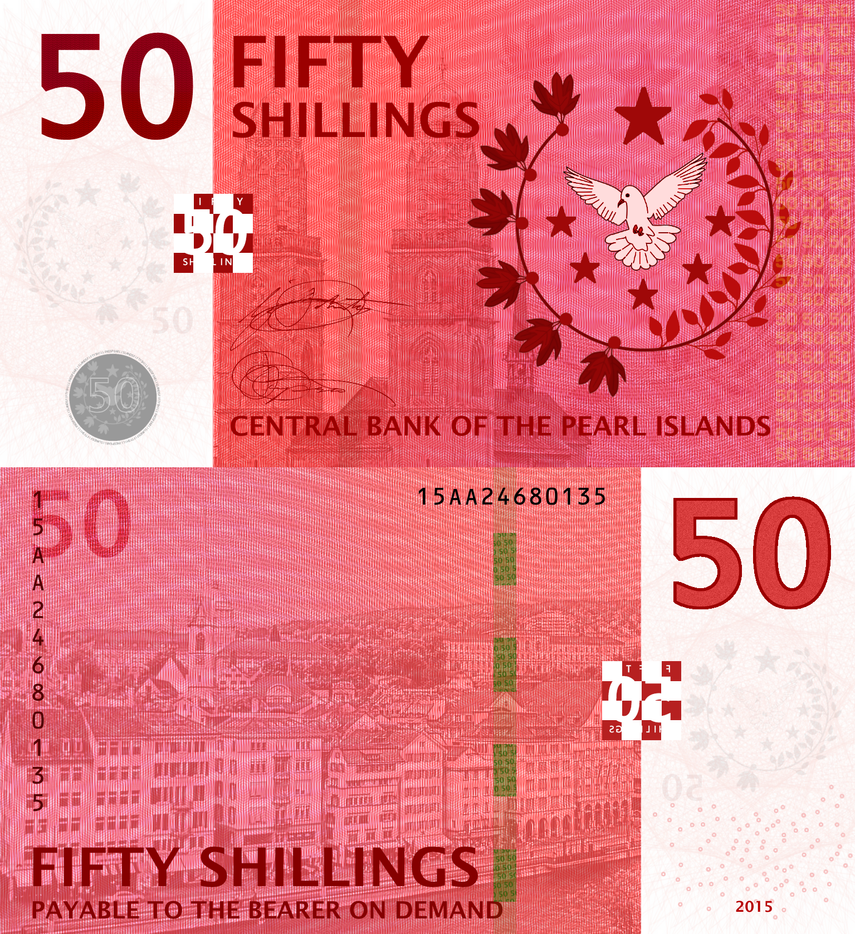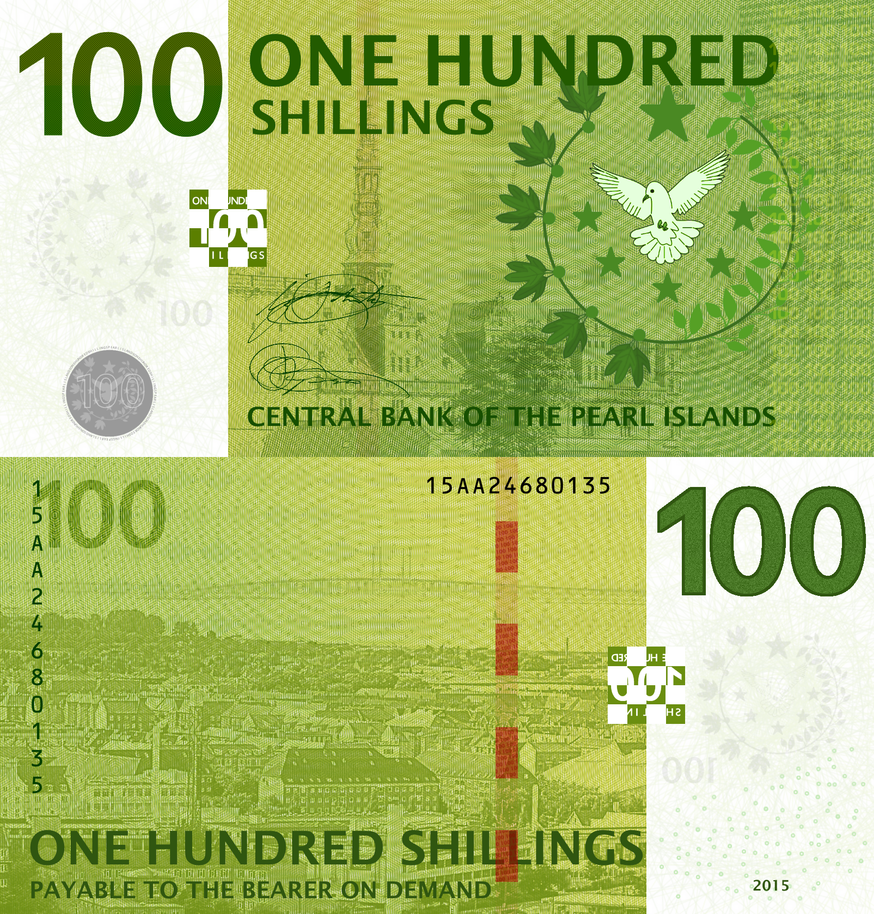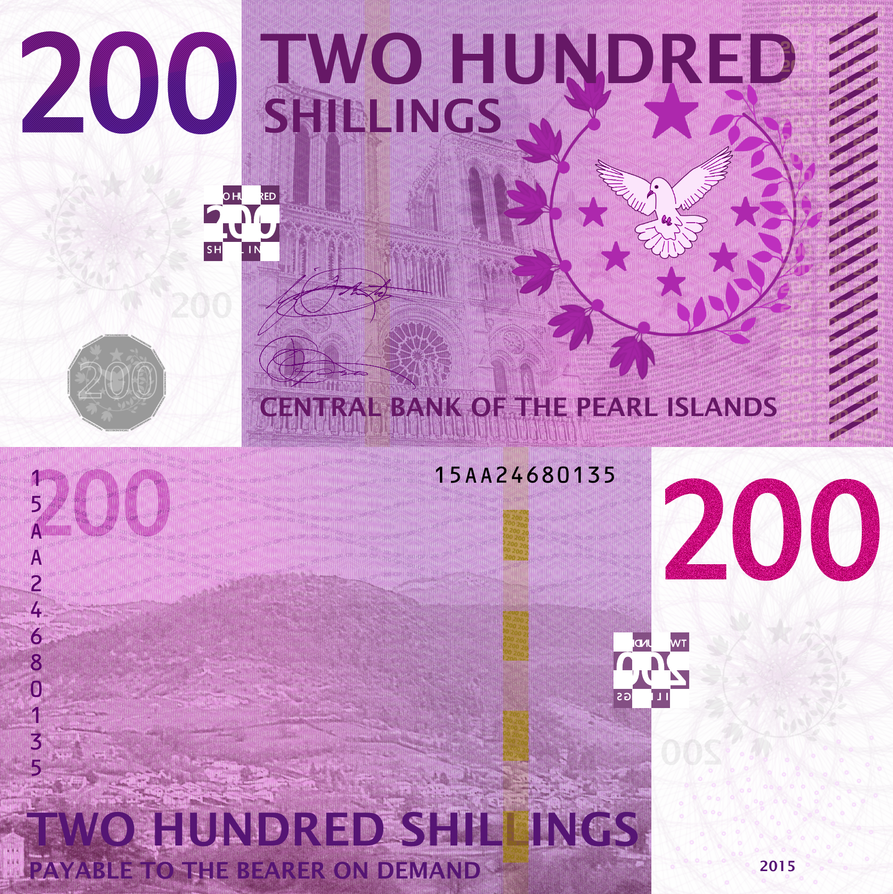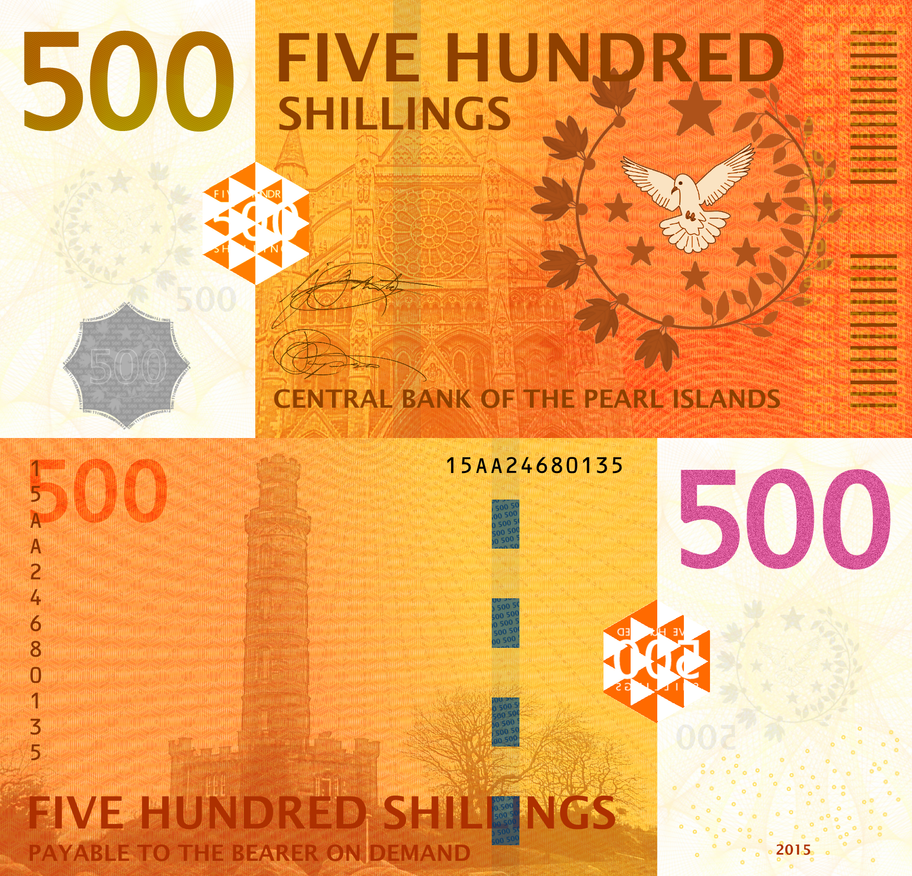Because I moved to a new institution, getting set up is taking a lot of time, especially when you need a specific chemical and it takes three weeks for it to arrive. Fun stuff. So I spent some time updating and upgrading one of my older projects, banknotes (and coins) for the Pearl Islands. However, the topic here are the banknotes.
First of all, the currency was one I imagined a bit to be like the old French franc and current Danish and Swedish crowns: about 7 or so to a dollar (well, that was the rate of the franc back when I travelled to France in the early 2000's), similar currency structure, and some of the banknote design elements taken from the Danish krone.
In thinking about redesigning, though, a question of practicality came up: these are islands, and transportation costs to and from said islands are really high; similar to the situation in Hawaii, most food needs to be imported, so the prices will correspondingly be pretty high. And that creates a bit of a need for higher-valued banknotes, especially if electronic payment penetration isn't very high (and sometimes even if it is... see the case of South Korea). Hence, a 500-shilling note got added.
Also, most countries use coins for denominations around $2 to $3 due to cost efficiency, meaning the 20-shilling note seems not very efficient. So that got replaced by a coin.
Anyways, without further ado...

50 shillings (USD 7 / EUR 6.50 / GBP 4.50)

100 shillings

200 shillings

500 shillings
Most commonly used notes are actually the 100 and 200, as ATMs are most likely to dispense these. The 500's are becoming increasingly used, but are far from being common.
Also, coins. Because I like coins, too.

The 5- and 10-cent coins are rather rare and only are used at some supermarkets and gas stations; in practice, the 25-cent coin is the smallest used coin. The 20-shilling is slowly becoming more and more common due to the discontinuation of the 20-franc note, though the ½ shilling coin isn't particularly common due to most rounding tending to disfavor its use.
First of all, the currency was one I imagined a bit to be like the old French franc and current Danish and Swedish crowns: about 7 or so to a dollar (well, that was the rate of the franc back when I travelled to France in the early 2000's), similar currency structure, and some of the banknote design elements taken from the Danish krone.
In thinking about redesigning, though, a question of practicality came up: these are islands, and transportation costs to and from said islands are really high; similar to the situation in Hawaii, most food needs to be imported, so the prices will correspondingly be pretty high. And that creates a bit of a need for higher-valued banknotes, especially if electronic payment penetration isn't very high (and sometimes even if it is... see the case of South Korea). Hence, a 500-shilling note got added.
Also, most countries use coins for denominations around $2 to $3 due to cost efficiency, meaning the 20-shilling note seems not very efficient. So that got replaced by a coin.
Anyways, without further ado...

50 shillings (USD 7 / EUR 6.50 / GBP 4.50)

100 shillings

200 shillings

500 shillings
Most commonly used notes are actually the 100 and 200, as ATMs are most likely to dispense these. The 500's are becoming increasingly used, but are far from being common.
Also, coins. Because I like coins, too.

The 5- and 10-cent coins are rather rare and only are used at some supermarkets and gas stations; in practice, the 25-cent coin is the smallest used coin. The 20-shilling is slowly becoming more and more common due to the discontinuation of the 20-franc note, though the ½ shilling coin isn't particularly common due to most rounding tending to disfavor its use.
Comments
8 years ago

These look very crisp and modern, so good job! I just wondered about "Payable to the bearer on demand," since I don't think that's been commonly printed on European bills anymore in a while, I think I've only seen it on old, pre-WW2 money? You're the expert, though. Might be a nod towards tradition for Pearl Islanders.
For the uninitiated, what's the case for South Korea? From context I suppose it means that electronic payment is basically non-existent there?
For the uninitiated, what's the case for South Korea? From context I suppose it means that electronic payment is basically non-existent there?
8 years ago

Thanks!
The "payable to the bearer" clause actually has appeared on a lot of more recent money, though, with the transition to fiat currencies, it's mostly symbolic more than anything. The last series of Italian lira notes said "payable to the bearer on sight", and current British pound sterling notes say "I promise to pay the bearer on demand the sum of ____________ pounds", a nod to the time when the banknotes were convertible for cash. Now, however, they're simply backed by the strength of the country and economy. So a relic of sorts.
The South Korea reference actually is that electronic payments are extremely common there, but it seems moreso with the younger generation which has fairly quickly adopted paying by mobile phone, for example. The older generations, though, still seem to prefer cold, hard cash for most day-to-day things, which necessitated the introduction of a 50 thousand won note back in 2009 or so (before that, the highest denomination was KRW 10000, which amounted to about US$8-$10).
The "payable to the bearer" clause actually has appeared on a lot of more recent money, though, with the transition to fiat currencies, it's mostly symbolic more than anything. The last series of Italian lira notes said "payable to the bearer on sight", and current British pound sterling notes say "I promise to pay the bearer on demand the sum of ____________ pounds", a nod to the time when the banknotes were convertible for cash. Now, however, they're simply backed by the strength of the country and economy. So a relic of sorts.
The South Korea reference actually is that electronic payments are extremely common there, but it seems moreso with the younger generation which has fairly quickly adopted paying by mobile phone, for example. The older generations, though, still seem to prefer cold, hard cash for most day-to-day things, which necessitated the introduction of a 50 thousand won note back in 2009 or so (before that, the highest denomination was KRW 10000, which amounted to about US$8-$10).
